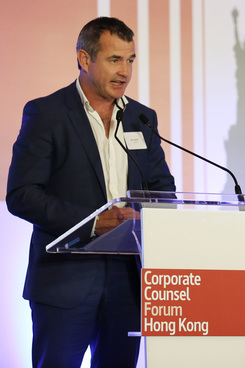Treating meeting addiction: how one legal team cut back on meetings - and found happiness
Escaping the cycle of relentless meetings might seem impossible, but Telstra and Herbert Smith Freehills found a more ruthless approach had a huge impact on productivity
May 12, 2017 at 12:00 AM
5 minute read
The original version of this story was published on Law.com
Last year, a tongue-in-cheek internal video featuring in-house lawyers at Australian telecoms company Telstra went viral among company employees. In the film, lawyers – including group general counsel Carmel Mulhern - proudly reported their achievements in rejecting meeting invitations and cutting back time spent on unproductive meetings.
"Now, instead of logging back on after dinner, I get to spend time with the family," said one lawyer in the film. The recovering 'meeting addicts' shared experiences of saying "no" to the numerous meetings that had consumed most of their working day, and they celebrated finally getting their lives back. Some used the time to get actual work done; some were able to achieve better work/life balance; and some spent that time learning new things, like playing the trumpet.
The video, while done with humour, was intended to showcase some of the results of a year-long experiment that explored ways to improve efficiency among the company's legal team. The initiative, dubbed the Telstra Legal Innovation Forum, is a collaboration between the telecom company's legal department and Herbert Smith Freehills. The programme launched in November 2015 with 30 members from both organisations, who zeroed in on a number of productivity issues and began tackling them. The team succeeded in resolving four of them by the end of the first year.
 One of the issues they addressed concerned the scheduling of too many internal meetings. In 2015, the legal team collectively spent more than 60,000 hours attending internal legal meetings, said Mick Sheehy (pictured), Telstra's general counsel in charge of finance and strategy, who described the experiment at this year's Corporate Counsel Forum in Hong Kong.
One of the issues they addressed concerned the scheduling of too many internal meetings. In 2015, the legal team collectively spent more than 60,000 hours attending internal legal meetings, said Mick Sheehy (pictured), Telstra's general counsel in charge of finance and strategy, who described the experiment at this year's Corporate Counsel Forum in Hong Kong.
"About half of these meetings are information-sharing meetings with other lawyers, including meetings where messages are cascaded multiple times over multiple meetings to audiences that have often already heard the same messages," Sheehy said. "We had a hunch we were spending too much time in internal legal meetings."
The innovation initiatives team decided to categorise all meetings into either an information-sharing meeting or a decision-making meeting. They then ran an eight-week trial, during which all lawyers were required to limit their information-sharing meetings to five hours every two weeks.
Decision-making meetings, meanwhile, had to meet three requirements before they could be scheduled: the decision that was to be made had to be articulated in the meeting invite; only lawyers who were absolutely necessary to make the decision could be invited; and all materials relevant to the decision had to be distributed and read before the meeting.
The changes resulted in a 50% reduction in both types of meetings. And 80% of the lawyers reported improvement in productivity after attending fewer meetings, Sheehy said.
In addition to reducing the number of scheduled meetings, the programme also ran trials that ultimately saved 5,300 hours in drafting confidentiality agreements – a decline of 82% from 2015. They also found ways to cut the amount of time spent on writing internal reports by two thirds. And they increased efficiency in the internal communications approval process by nearly 30%.
In the end, the programme managed to eliminate more than 40,000 hours of low value, non-strategic work – the equivalent of 17 full-time employees in a team of approximately 200, according to Sheehy. "These time savings are not about headcount reduction," he said. "A substantial portion of these savings help us spend more time on strategic work, achieving better work/life balance for our team and enabling our people to invest even more of their time on innovation."
The innovation forum, which continues to run in 2017, is part of an effort to install dedicated legal operations management at Telstra's in-house legal department. The process started in 2013, when senior lawyers at Australia's largest telecoms service provider started pondering innovation in the face of an annual 10% budget cut.
Lawyers then produced a long, comprehensive, detailed and well-worded list of all of the things they could do to improve productivity in Telstra Legal. "I recall us being very proud of producing that list. With that out of the way, we all returned to our desks to attend to our day jobs," Sheehy said.
But not much changed.
"Of course, we didn't have any real plan to bring any of those items to life other than that we all agreed they were very important. We also seemed to think if we all shared the responsibility, that would maximise the chances of things getting achieved."
Eventually, they realised that the only way to make change happen was to have someone whose only job was to see those changes through. Telstra made its first move by hiring then King & Wood Mallesons Melbourne partner Amanda Bodger as head of people and operations for the legal department in late 2013.
Bodger runs a lean team of four people who oversee operations of Telstra's 200-lawyer legal department in Australia. The team has helped the legal department be more efficient, flexible and diverse in expertise.
Sheehy said the work has just began. "I don't think we are by any means there yet in terms of this role," he said. "We need to beef up the legal operations function further. We need tech specialists and data analysts. I'm confident we'll do this over time as we get better at framing the business case for this investment."
"But the initial appointment is certainly the most important step."
Click here for more information on the Corporate Counsel Forum Hong Kong.
Related events
This content has been archived. It is available through our partners, LexisNexis® and Bloomberg Law.
To view this content, please continue to their sites.
Not a Lexis Subscriber?
Subscribe Now
Not a Bloomberg Law Subscriber?
Subscribe Now
NOT FOR REPRINT
© 2025 ALM Global, LLC, All Rights Reserved. Request academic re-use from www.copyright.com. All other uses, submit a request to [email protected]. For more information visit Asset & Logo Licensing.
You Might Like
View All
GCs Responsible for Gender Balanced Boardrooms Under New EU Rules

A Dark Future of Deepfakes and Disobedient AI: What GCs Foresee For 2050
3 minute readTrending Stories
- 1'It's Not Going to Be Pretty': PayPal, Capital One Face Novel Class Actions Over 'Poaching' Commissions Owed Influencers
- 211th Circuit Rejects Trump's Emergency Request as DOJ Prepares to Release Special Counsel's Final Report
- 3Supreme Court Takes Up Challenge to ACA Task Force
- 4'Tragedy of Unspeakable Proportions:' Could Edison, DWP, Face Lawsuits Over LA Wildfires?
- 5Meta Pulls Plug on DEI Programs
Who Got The Work
Michael G. Bongiorno, Andrew Scott Dulberg and Elizabeth E. Driscoll from Wilmer Cutler Pickering Hale and Dorr have stepped in to represent Symbotic Inc., an A.I.-enabled technology platform that focuses on increasing supply chain efficiency, and other defendants in a pending shareholder derivative lawsuit. The case, filed Oct. 2 in Massachusetts District Court by the Brown Law Firm on behalf of Stephen Austen, accuses certain officers and directors of misleading investors in regard to Symbotic's potential for margin growth by failing to disclose that the company was not equipped to timely deploy its systems or manage expenses through project delays. The case, assigned to U.S. District Judge Nathaniel M. Gorton, is 1:24-cv-12522, Austen v. Cohen et al.
Who Got The Work
Edmund Polubinski and Marie Killmond of Davis Polk & Wardwell have entered appearances for data platform software development company MongoDB and other defendants in a pending shareholder derivative lawsuit. The action, filed Oct. 7 in New York Southern District Court by the Brown Law Firm, accuses the company's directors and/or officers of falsely expressing confidence in the company’s restructuring of its sales incentive plan and downplaying the severity of decreases in its upfront commitments. The case is 1:24-cv-07594, Roy v. Ittycheria et al.
Who Got The Work
Amy O. Bruchs and Kurt F. Ellison of Michael Best & Friedrich have entered appearances for Epic Systems Corp. in a pending employment discrimination lawsuit. The suit was filed Sept. 7 in Wisconsin Western District Court by Levine Eisberner LLC and Siri & Glimstad on behalf of a project manager who claims that he was wrongfully terminated after applying for a religious exemption to the defendant's COVID-19 vaccine mandate. The case, assigned to U.S. Magistrate Judge Anita Marie Boor, is 3:24-cv-00630, Secker, Nathan v. Epic Systems Corporation.
Who Got The Work
David X. Sullivan, Thomas J. Finn and Gregory A. Hall from McCarter & English have entered appearances for Sunrun Installation Services in a pending civil rights lawsuit. The complaint was filed Sept. 4 in Connecticut District Court by attorney Robert M. Berke on behalf of former employee George Edward Steins, who was arrested and charged with employing an unregistered home improvement salesperson. The complaint alleges that had Sunrun informed the Connecticut Department of Consumer Protection that the plaintiff's employment had ended in 2017 and that he no longer held Sunrun's home improvement contractor license, he would not have been hit with charges, which were dismissed in May 2024. The case, assigned to U.S. District Judge Jeffrey A. Meyer, is 3:24-cv-01423, Steins v. Sunrun, Inc. et al.
Who Got The Work
Greenberg Traurig shareholder Joshua L. Raskin has entered an appearance for boohoo.com UK Ltd. in a pending patent infringement lawsuit. The suit, filed Sept. 3 in Texas Eastern District Court by Rozier Hardt McDonough on behalf of Alto Dynamics, asserts five patents related to an online shopping platform. The case, assigned to U.S. District Judge Rodney Gilstrap, is 2:24-cv-00719, Alto Dynamics, LLC v. boohoo.com UK Limited.
Featured Firms
Law Offices of Gary Martin Hays & Associates, P.C.
(470) 294-1674
Law Offices of Mark E. Salomone
(857) 444-6468
Smith & Hassler
(713) 739-1250











